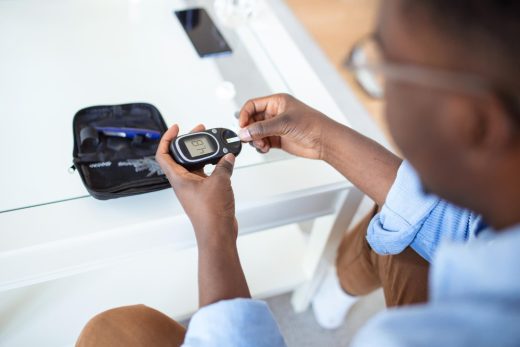
Young man using digital glucometer at home Diabetes control
Kampala, Uganda— A new study published in BMC Health Services Research suggests that a readily available blood test could significantly improve diabetes screening efforts in Uganda and other low-resource countries while also saving money. The study, done by a team from Makerere University School of Public Health (MakSPH) and international partners, discovered that using the glycated hemoglobin (HbA1c) test right where patients are treated is cheaper than the usual fasting plasma glucose (FPG) test.
Type 2 diabetes is a growing global health crisis, with the most significant increases expected in low- and middle-income countries, including those in sub-Saharan Africa. In Uganda, diabetes is a major cause of severe health complications, such as vision loss, kidney failure, heart attacks, strokes, and non-traumatic lower limb amputations. According to the International Diabetes Federation, around 716,000 Ugandan adults were living with diabetes in 2021. Worryingly, about 89% of them are either unaware of their condition or not receiving treatment, often presenting to healthcare facilities only after developing complex, challenging-to-treat complications.
“Early detection is paramount,” explains Dr. Francis Xavier Kasujja, lead author of the study and a researcher at Makerere University. “The longer diabetes goes undiagnosed, the greater the risk of severe health consequences, placing a further strain on already burdened healthcare systems.”
The FPG test, which requires patients to fast for at least eight hours, has been the standard for diabetes screening in Uganda. However, the need for fasting presents logistical challenges, often requiring patients to make a second trip to the clinic. This, researchers say, can be a significant barrier, particularly for those living in rural areas with limited access to transportation.
The HbA1c test, on the other hand, offers a more convenient alternative. It does not require fasting and provides a measure of average blood sugar levels over the past two to three months. While HbA1c testing has been available, concerns about its cost-effectiveness in resource-constrained settings have limited its widespread adoption.
To address this, Dr. Kasujja, alongside Dr. Meena Daivadanam, Dr. Roy William Mayega, Professor Fred Nuwaha, Ronald Kusolo, and Dr. Elizabeth Ekirapa, constructed a decision analysis model to compare the costs and effectiveness of the two tests in a hypothetical screening scenario at the outpatient department of Iganga Hospital, a general hospital in eastern Uganda.
Their analysis considered a wide range of factors, including the cost of test kits, equipment, personnel, and, crucially, the costs incurred by patients.
The study found that although the unit cost of the HbA1c test, which measures average blood sugar levels over two to three months, was higher, it remained the more cost-effective option for diagnosing and monitoring diabetes and prediabetes. The difference was primarily due to the significant savings in patient costs, as individuals did not need to return for a fasting appointment.
“Patient costs contributed 65% to HbA1c testing compared to 90% for FPG testing,” the study states. This difference highlights the significant economic burden placed on patients when using the FPG test.
“Our findings suggest that HbA1c point-of-care testing could be a game-changer for diabetes screening in Uganda,” says Dr. Kasujja. “By eliminating the need for fasting, we can make testing more accessible and convenient, leading to earlier diagnoses and improved health outcomes.”
The study concluded that HbA1c point-of-care (POC) testing is a more cost-effective approach for diabetes screening in underserved outpatient populations in Uganda and similar settings. Despite its higher initial cost, the HbA1c test offers significant advantages, including the ability to diagnose diabetes at any time of day, without the need for fasting, potentially increasing early detection rates. This approach could lead to long-term cost savings by identifying more people with diabetes earlier, reducing the burden of undiagnosed cases.
As the study notes, “Investing in HbA1c testing as the foundation of Uganda’s early diabetes screening programs could save costs over time and improve patient outcomes by catching cases earlier.”
The study’s authors acknowledge some limitations, including the use of data extrapolated from whole blood specimens and the lack of adjustment for potential variations in HbA1c levels due to genetic diversity. However, they emphasize that the results provide credible information for policymakers and healthcare providers in Uganda and similar settings.
“This research provides compelling evidence that HbA1c testing can be a cost-effective strategy for diabetes screening in low-resource settings,” comments Dr. Roy Mayega, an NCDs Subject Matter Expert at MakSPH but also one of the investigators in the study. “The findings suggest that one must take into account patient costs when evaluating the economic impact of different diagnostic approaches.”
The authors recommend further research to explore the long-term impact of HbA1c testing on diabetes management and to assess the feasibility of implementing HbA1c-based screening programs in various healthcare settings in Uganda.
With diabetes rates on the rise, innovative and cost-effective solutions like HbA1c testing are crucial for tackling this growing public health challenge.
Davidson Ndyabahika
Science and Health Communication Specialist


